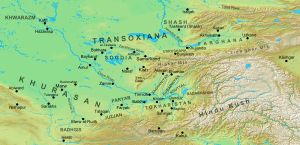
The Umayyad Caliphate was the second caliphate established after the death of the Islamic prophet Muhammad. The caliphate was ruled by the Umayyad dynasty, also known as the Umayyads. Uthman ibn Affan, the third of the Rashidun caliphs, was also a member of the clan. The family established dynastic, hereditary rule with Muawiya ibn Abi Sufyan, long-time governor of Greater Syria, who became caliph after the end of the First Fitna in 661. After Mu'awiya's death in 680, conflicts over the succession resulted in the Second Fitna, and power eventually fell to Marwan I, from another branch of the clan. Syria remained the Umayyads' main power base thereafter, with Damascus as their capital.
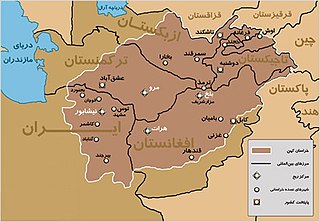
Greater Khorāsān, or Khorāsān, is a historical eastern region in the Iranian Plateau between Western and Central Asia. The name Khorāsān is Persian meaning "where the sun arrives from" or "the Eastern Province". The name was first given to the eastern province of Persia during the Sasanian Empire and was used from the late Middle Ages in distinction to neighbouring Transoxiana. Greater Khorasan is today sometimes used to distinguish the larger historical region from the former Khorasan Province of Iran (1906–2004), which roughly encompassed the western portion of the historical Greater Khorasan.

Ikhshid was the princely title of the Iranian rulers of Soghdia and the Ferghana Valley in Transoxiana during the pre-Islamic and early Islamic periods. The title is of Iranian origin; scholars have derived it variously from the Old Iranian root khshaeta, "shining, brilliant", or from khshāyathiya, "ruler, king".
Yazid ibn al-Muhallab al-Azdi was a commander and statesman for the Umayyad Caliphate in Iraq and Khurasan in the early 8th century. In 720, he led the last of a series of wide scale Iraqi rebellions against the Umayyads.

Chaghaniyan, known as al-Saghaniyan in Arabic sources, was a medieval region and principality located on the right bank of the Oxus River, to the south of Samarkand.
Abū Ḥafṣ Qutayba ibn Abī Ṣāliḥ Muslim ibn ʿAmr al-Bāhilī was an Arab commander of the Umayyad Caliphate who became governor of Khurasan and distinguished himself in the conquest of Transoxiana during the reign of al-Walid I (705–715). A capable soldier and administrator, he consolidated Muslim rule in the area and expanded the Caliphate's border to include most of Transoxiana. From 705 to c. 710, he consolidated Muslim control over the native principalities of Tokharistan and conquered the principality of Bukhara, while in 710–712 he conquered Khwarizm and completed the conquest of Sogdiana with the capture of Samarkand. The latter opened the road to the Jaxartes valley, and during the last years of his life Qutayba led annual campaigns there, extending Muslim control up to the Fergana Valley and parts of Chinese Turkestan.

The Battle of the Defile or Battle of the Pass was fought in the Takhtakaracha Pass between a large army of the Umayyad Caliphate and the Turkic Türgesh khaganate over three days in July 731 CE. The Türgesh had been besieging Samarkand, and Samarkand's commander, Sawra ibn al-Hurr al-Abani, had sent a request for relief to the newly appointed governor of Khurasan, Junayd ibn Abd al-Rahman al-Murri. Junayd's 28,000-strong army was attacked by the Türgesh in the pass, and although the Umayyad army managed to extricate itself and reach Samarkand, it suffered enormous casualties; Sawra's 12,000 men, who had been commanded to attack the Türgesh from the rear in a relief effort, were almost annihilated.
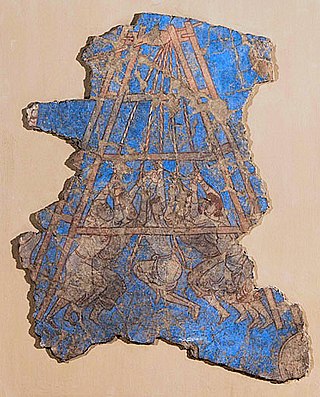
The Muslim conquest of Transoxiana or Arab conquest of Transoxiana were the 7th and 8th century conquests, by Umayyad and Abbasid Arabs, of Transoxiana, the land between the Oxus and Jaxartes rivers, a part of Central Asia that today includes all or parts of Uzbekistan, Tajikistan, Kazakhstan, and Kyrgyzstan.

Transoxiana or Transoxania is the Latin name for a region and civilization located in lower Central Asia roughly corresponding to modern-day eastern Uzbekistan, western Tajikistan, parts of southern Kazakhstan, parts of Turkmenistan and southern Kyrgyzstan. Geographically, it is the region between the rivers Amu Darya to its south and the Syr Darya to its north.
Gurak or Ghurak was a medieval Sogdian ruler in Central Asia during the period of the Muslim conquest of Transoxiana. In 710, he was installed as king of Samarkand after the populace overthrew his predecessor, Tarkhun, due to his pro-Muslim stance. The Umayyad governor, Qutayba ibn Muslim, campaigned against Samarkand but in the end confirmed Gurak as its ruler. Gurak was a cautious and intelligent ruler, and managed, through shifting alliance between the Muslims and the Turgesh, to remain on his throne. Some time after the Muslim Pyrrhic victory Battle of the Defile in 731, he managed to recover his capital, Samarkand, and achieve a quasi-independence which he maintained until his death in 737 or 738. His realm was then divided among his relatives : Turgar, formerly prince of Kabudhan, received Samarkand, Me-chu'o was king of Mayamurgh, while a certain Ko-lopu-lo who was king of Ishtikhan in 742 may perhaps be identified with Gurak's brother Afarun.

The "Day of Thirst" is the name traditionally given in Arabic historiography to a battle fought in 724 between the Turkic Türgesh Khaganate and the Umayyad Caliphate on the banks of the Syr Darya river, in Transoxiana. The Umayyad army, under Muslim ibn Sa'id al-Kilabi, was campaigning in the Ferghana Valley when it learned of the Türgesh advance. Immediately, the Arabs began a hasty retreat to the Jaxartes, pursued and harassed by the Türgesh cavalry. Finally, after 11 days, the Umayyad army reached the Jaxartes, where it was caught between the Türgesh and the forces of the native Transoxianian principalities. Nevertheless, the Arabs managed to break through and cross the river to Khujand. The Umayyad defeat led to the collapse of Muslim rule over much of the region, which until c. 740 remained disputed territory, with both the Arabs and the Türgesh fighting for control over it.

Divashtich, was a medieval Sogdian ruler in Transoxiana during the period of the Muslim conquest of Transoxiana. He was the ruler of Panjikant and its surroundings from ca. 706 until his downfall and execution in the autumn of 722.
The Bukhar Khudahs or Bukhar Khudats were a local Sogdian dynasty, which ruled the city of Bukhara from an unknown date to the reign of the Samanid ruler Isma'il ibn Ahmad, who incorporated Bukhara into the Samanid state.
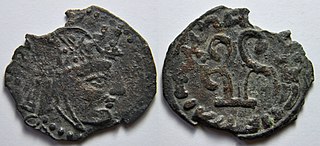
Azkajwar II was the ruler of the Afrighid dynasty of Khwarezm from an unknown date to 712. He was the son and successor of Sabri. Azkajwar II is agreed by most scholars to be the same person as king Jigan or Chigan. In most medieval sources, he is simply called Khwarazmshah.

The Principality of Chaghaniyan, known in Arabic sources as al-Saghaniyan, was a part of the Hephthalite Confederation from the 5th to the 7th century CE. After this, it was ruled by a local, presumably Iranian dynasty, which governed the Chaghaniyan region from the late 7th-century to the early 8th-century CE. These rulers were known by their titles of “Chaghan Khudah”.
Bindu of Bukhara was Bukhar Khudah from an unknown date to 681. Several rulers of Bukhara are known before him, however, it is not known if they were from the same dynasty. Bindu had a wife who is only known by her title of Khatun, who bore him a son named Tughshada. In 681, during the Muslim conquest of Transoxiana, Bindu was killed by the Umayyad general Salm ibn Ziyad. He was succeeded by his few months old son Tughshada.

The Principality of Ushrusana was a local dynasty ruling the Ushrusana region, in the northern area of modern Tajikistan, from an unknown date to 892 CE. Ushrusana, just like Ferghana, did not belong to Sogdia proper, but its inhabitants wrote in Sogdian, and may have spoken the Sogdian language as well. The rulers of the principality were known by their title of Afshin.

The Principality of Farghana, was a local Iranian dynasty of Sogdian origin, which ruled the Farghana region from an unknown date to 819. The rulers of the region were known by their titles of “ikhshid” and “dehqan”. The capital of the principality was Akhsikath.
The Muslim conquest of Khorasan was the last phase of the heavy war between the Rashidun caliphate against the Sassanid Empire.
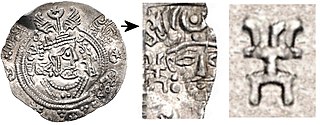
Nezak Tarkhan was a nomadic ruler of Tokharistan who led a revolt against the Arab commander Qutayba bin Muslim around 709 CE.
